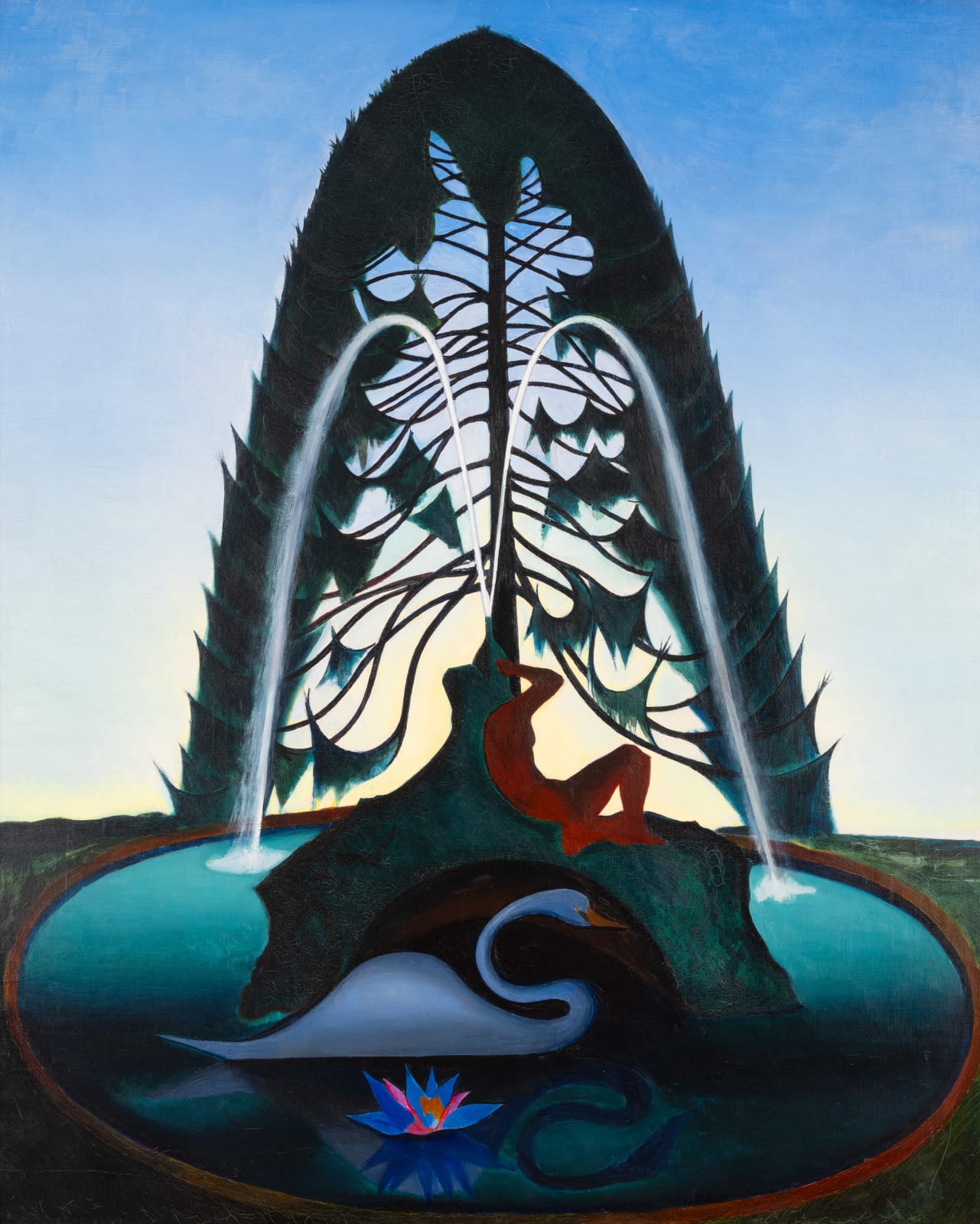Joseph Stella Italian, American, 1877-1946
124.5 x 101.6 cm
Over the course of Joseph Stella's four-decade career, flora, fauna, and lush landscapes of an imagined world became his most passionately pursued subject...His pictures of flowers, plants, and birds were rooted in another, more ancient, primal, and Arcadian world. Inspired by archaic, folk, and classical precedents and his own brand of spirituality, these lyrical and exuberant works are also his least understood.
Stella’s initial turn to a self-directed study of the technical achievements and styles of the Renaissance also anchored him to an Italian heritage—an identity he would later associate with the exploration of nature in his art.
If Stella’s embrace of nature subjects took root in New York, it fully blossomed on his 1922 visit to Italy. Unlike in New York, where Stella encountered nature largely in contained gardens, the natural world was ever present in rural Italy. The
familiar landmarks of Mt. Vesuvius, the Bay of Naples, and Capri provided the backdrop for his evolving visual language. Seized by a “mystical rapture” and stirred by a landscape alive with history, he adopted a crisp, archaic style for these
works.
The Italian pictures confused American critics, who had come to know Stella for his paintings of the modern American city. Nevertheless, even at a moment of rising anti-Catholic and anti-immigrant sentiment in America, he proudly
aligned with his Italian identity. His shift announced a direct lineage to medieval and early Renaissance Italian art, which he admired for its pure and uncomplicated style. Stella’s Italy was about color, light, and simplicity of expression. Folk traditions inspired this series, not just the studied perfection of artists like Michelangelo and others of the High Renaissance.
Nature is the true subject of Stella’s Italy paintings.
In the final years of his life, [nature] assumed an even more central role for Stella, who continued to view nature as a metaphor for his own existence and death. “I may ask one simple thing,” he said in a 1929 interview, “to be left free to face the Sun.”
While Stella achieved celebrity and acclaim for his innovative spirit, what many praised as the uniqueness and range of his vision also became Stella’s greatest obstacle to enduring success. As one observant critic, Hilton Kramer for The New York Times, explained in a largely positive review of a Stella retrospective at the Robert Schoelkopf Gallery in 1977, the artist’s “untidy” and “contradictory career” confounded his legacy. “Stella was at once a modernist and a traditionalist,” Kramer
observed, “a Futurist who still worshipped at the shrine of the old Masters, an artist with a passion for the romance of industrial America who constantly fled to . . . exotic locales . . . to renew his inspiration.”
Making sense of Stella requires a disregard of conventional categories, as he fits into none of them neatly. Yet precisely because his art transcends categorization, it achieves something else entirely: universality. In his visionary pursuit to
find something new to say about the world around him, he invites us all to see our own world anew.
Provenance
The artist; to[Rabin and Kruger, Newark, New Jersey]; to
Private collection, circa 1961; to
Private collection, circa 1996 until the present
Exhibitions
Whitney Museum of American Art, New York, Joseph Stella, April 22–October 9, 1994, no. 190Owen Gallery, New York, American Modern, April 12–June 12, 2001
Norton Museum of Art, West Palm Beach, Florida; High Museum of Art, Atlanta, Georgia; Brandywine Museum of Art, Chadds Ford, Pennsylvania, Joseph Stella: Visionary Nature, October 15, 2022–September 24, 2023
Schoelkopf Gallery, New York, Joseph Stella: Unsealed from Paradise, October 12–December 1, 2023
La Biennale di Venezia, Italy, 60th International Art Exhibition: Stranieri Ovunque—Foreigners Everywhere, April 20-November 24, 2024
Literature
Barbara Haskell, Joseph Stella, New York: Whitney Museum of American Art, 1994, p. 269, no. 190, illus. p. 160Stephanie Mayer Heydt, Ellen E. Roberts, Karli Wurzelbacher, Ara H. Merjian, and Audrey Lewis, Joseph Stella: Visionary Nature, Atlanta: High Museum of Art, 2022, p. 207, pl. 87, fig. 2, illus. in color pp. 17 and 141
Kristin Nord, "Brandywine Museum of Art, Joseph Stella: Visionary Nature," Antiques and The Arts Weekly, July 11, 2023, illus. in color
Subscribe to our mailing list to receive updates from the gallery
* denotes required fields
We will process the personal data you have supplied in accordance with our privacy policy (available on request). You can unsubscribe or change your preferences at any time by clicking the link in our emails.

